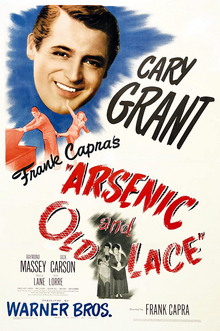
Back Arsenic and Old Lace (cinta) AN Арсеник и стари дантели (филм) Bulgarian Arsènic per compassió Catalan Arsenig a Hen Las Welsh Arsen und Spitzenhäubchen German Αρσενικό και παλιά δαντέλα (ταινία) Greek Arsenic and Old Lace Spanish Arsenic and Old Lace (filma) Basque آرسنیک و تور کهنه Persian Arsenikkia ja vanhoja pitsejä Finnish
| Arsenic and Old Lace | |
|---|---|
 Theatrical release poster | |
| Directed by | Frank Capra |
| Screenplay by | |
| Based on | Arsenic and Old Lace by Joseph Kesselring |
| Produced by |
|
| Starring | |
| Cinematography | Sol Polito |
| Edited by | Daniel Mandell |
| Music by | Max Steiner |
| Distributed by | Warner Bros. |
Release dates |
|
Running time | 118 minutes |
| Country | United States |
| Language | English |
| Budget | $1.2 million[2] |
| Box office | $4.8 million[2] |
Arsenic and Old Lace is a 1944 American screwball black comedy crime film directed by Frank Capra and starring Cary Grant. The screenplay by Julius J. Epstein and Philip G. Epstein is based on Joseph Kesselring's 1941 play of the same name.[3] The contract with the play's producers stipulated that the film would not be released until the Broadway run ended. The original planned release date was September 30, 1942. The play was hugely successful, running for three and a half years, so the film was not released until 1944.
The lead role of Mortimer Brewster was originally intended for Bob Hope, but he could not be released from his contract with Paramount Pictures. Capra had also approached Jack Benny and Richard Travis before learning that Grant would accept the role. On the Broadway stage, Boris Karloff played Jonathan Brewster, who is said to "look like Boris Karloff". According to Turner Classic Movies, Karloff, who gave permission for the use of his name in the film, remained in the play to appease the producers, who were afraid of what stripping the play of all its primary cast would do to ticket sales.[4] Raymond Massey took Karloff's place on screen.[5][Note 1] The film's supporting cast also features Jack Carson, Priscilla Lane, Peter Lorre, and Edward Everett Horton.
Josephine Hull and Jean Adair portray the Brewster sisters, Abby and Martha, respectively. Hull and Adair, as well as John Alexander (who played Teddy Brewster), reprised their roles from the 1941 stage production.[4] Hull and Adair both received an eight-week leave of absence from the stage production, which was still running, but Karloff did not, as he was an investor in the stage production and its main draw. The entire film was shot within those eight weeks. The film cost just over $1.2 million of a $2 million budget to produce.[7] The cost of the filming rights was $175,000.[8]
- ^ "'Arsenic and Old Lace,' With Cary Grant, in Premiere at Strand – 'Youth Runs Wild' Is New Palace Theatre Feature". The New York Times. September 2, 1944. Archived from the original on April 8, 2019. Retrieved July 22, 2020.
- ^ a b Warner Bros financial information in The William Schaefer Ledger. See Appendix 1, Historical Journal of Film, Radio and Television, (1995) 15:sup1, 1-31 p 25 DOI: 10.1080/01439689508604551
- ^ McGilligan 1986, p. 170.
- ^ a b "Arsenic and Old Lace (1944) – Notes". Turner Classic Movies. Archived from the original on January 18, 2016. Retrieved December 24, 2022.
- ^ Atkinson, Brooks (January 11, 1941). "The Play; Joseph Kesselring's 'Arsenic and Old Lace' Turns Murder Into Fantastic Comedy". The New York Times. Retrieved December 24, 2022.
- ^ Nixon, Rob. "The big idea behind Arsenic and Old Lace". Turner Classic Movies. Archived from the original on April 26, 2013. Retrieved June 25, 2012.
- ^ "Special feature section." Arsenic and Old Lace, DVD release: 65025.1B.
- ^ "Film Rights $ Up and Up; Hollywood Gets Taken But Presitige Pix Pay." Billboard 55:49 (4 December 1943), 4.
Cite error: There are <ref group=Note> tags on this page, but the references will not show without a {{reflist|group=Note}} template (see the help page).